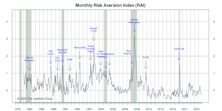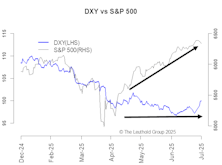Macro Monitor
The Decades They Are A-Changin’
More than halfway through the decade, a lot of things have changed. We revisit several decade-defining charts from the 2010s and consider where these long-running trends stand today.
Risk Aversion Index: Stayed On “Lower-Risk” Signal
The favorable seasonal window is upon us and the Fed liquidity condition is poised to turn more positive.
Another Loan Bites The Dust—Macro Implications Of Bank Stocks
There is consistent evidence that bank stocks behave like macro proxies. Both domestically and in other major economies across the globe, there is a strong and steady link between lending conditions and subsequent economic activity.
Risk Aversion Index: Stayed On “Lower-Risk” Signal
Monetary and fiscal policies continue to be supportive of risky assets—and the favorable seasonal window is upon us.
Recession Dashboard Update—Low Recession Risk
The stock rally and associated wealth effect make an imminent recession less likely (data that corroborates our Up/Down Earnings figures). Yet, things can change quickly when so much is riding on the market. Employment is still the biggest threat.
Risk Aversion Index: Stayed On “Lower-Risk” Signal
With a supportive backdrop of a more accommodative Fed and expansive fiscal stance, markets have grown accustomed to spinning both good and bad news into a positive narrative. Within fixed income, we remain constructive toward higher-quality credit.
Not All Cash Is Equal—A Tale Of Two Sizes
An examination of how large- and small-cap companies allocate cash across three main uses: investment (Capex and R&D), shareholder returns (dividends and buybacks), and M&A. We further evaluate how, over time, the market rewards or penalizes each.
Risk Aversion Index: Stayed On “Lower-Risk” Signal
Inflation and bond yields, alike, remain well behaved, which is a positive for risky assets. Among fixed income, we are still constructive toward higher-quality credit.
U.S. Dollar—Buy The Dip
The U.S. dollar has seen some interesting dynamics this year, so we’ve updated our U.S. Dollar Monitor. Currently, the model implies a higher likelihood of dollar strength, or at least a decent rebound over the next few months.
FAQ On Stablecoins
Stablecoins are reshaping the financial landscape by combining the stability of the U.S. dollar with the speed and global reach of crypto technology. Backed by short-term Treasuries and used across DeFi, payments, and remittances, they’re becoming digital cash for the internet era. With new U.S. legislation unlocking growth, their impact on banking, global dollar dominance, and Treasury demand is just beginning.
Risk Aversion Index: Stayed On “Lower-Risk” Signal
With the general backdrop of an easing Fed and expansive fiscal stance, the economy should be doing okay.
The Fed Pause Playbook—2025 In Historical Context
Economic resilience that prompted the Fed’s pause is consistent with past cases. Equities and bonds have largely followed historical patterns. The exceptions—gold’s outsized return and the dollar’s weakness—highlight the unique risks introduced by the current political environment.
Recession Dashboard Update—Lower Recession Risk
On the whole, the probability of an imminent recession has declined since our last update in April and now stands below 50%. Only two signals changed in this update, the most significant being the S&P 500, which improved from yellow to green.
Risk Aversion Index: A New “Lower-Risk” Signal
We turned constructive toward higher-quality credit.
Bank Lending Slowing? Watch Credit Spreads
Despite heightened uncertainty from shifting trade policies, credit markets remain relatively stable—at least for now. While bank lending standards are tightening and loan demand is softening, market-based indicators like credit spreads and bank stock performance suggest credit risk is contained. If that holds, the broader economy may avoid serious damage, even as tariffs rise.
Risk Aversion Index: Stayed On “Higher-Risk” Signal
While the “Trump put” materialized in May, the markets are again becoming complacent toward both policy uncertainty and geopolitical risks.
Anatomy Of A Major Selloff—A Cross-Asset Look
In exploring how cross-asset behavior differs between recessionary and non-recessionary market selloffs, a more striking conclusion emerged: The presence of a Fed put—or the absence there of—looks to be the more powerful force in shaping market dynamics across assets.
Risk Aversion Index: Stayed On “Higher-Risk” Signal
Despite recent policy back-pedaling, volatility is liable to stay elevated for the time being.
Slowdown Or Recession? Watch The S&P 500 Index!
Uncertainty surrounding Trump’s second term and the risk of escalating tariffs have shifted market focus from inflation to growth, raising fresh concerns about a potential recession. Our updated Recession Dashboard shows a delicate balance, with risk now slightly above 50%—driven largely by weakness in equities and full-time employment. While some indicators have improved, the market remains the most important signal to watch. A sharp selloff could tip the economy from slowdown into recession territory.
Risk Aversion Index: Stayed On “Higher-Risk” Signal
Within fixed income, we remain defensive toward credit, especially the low quality segment.




















